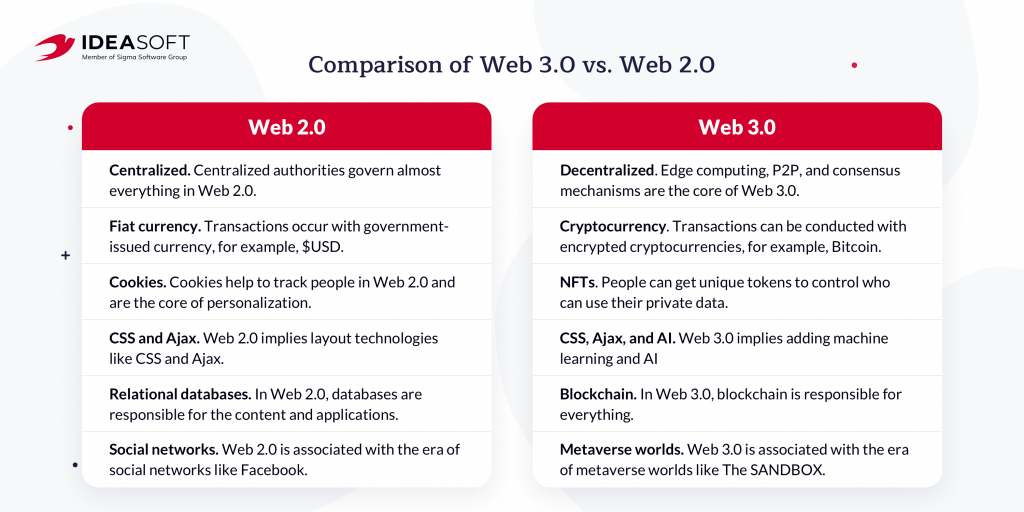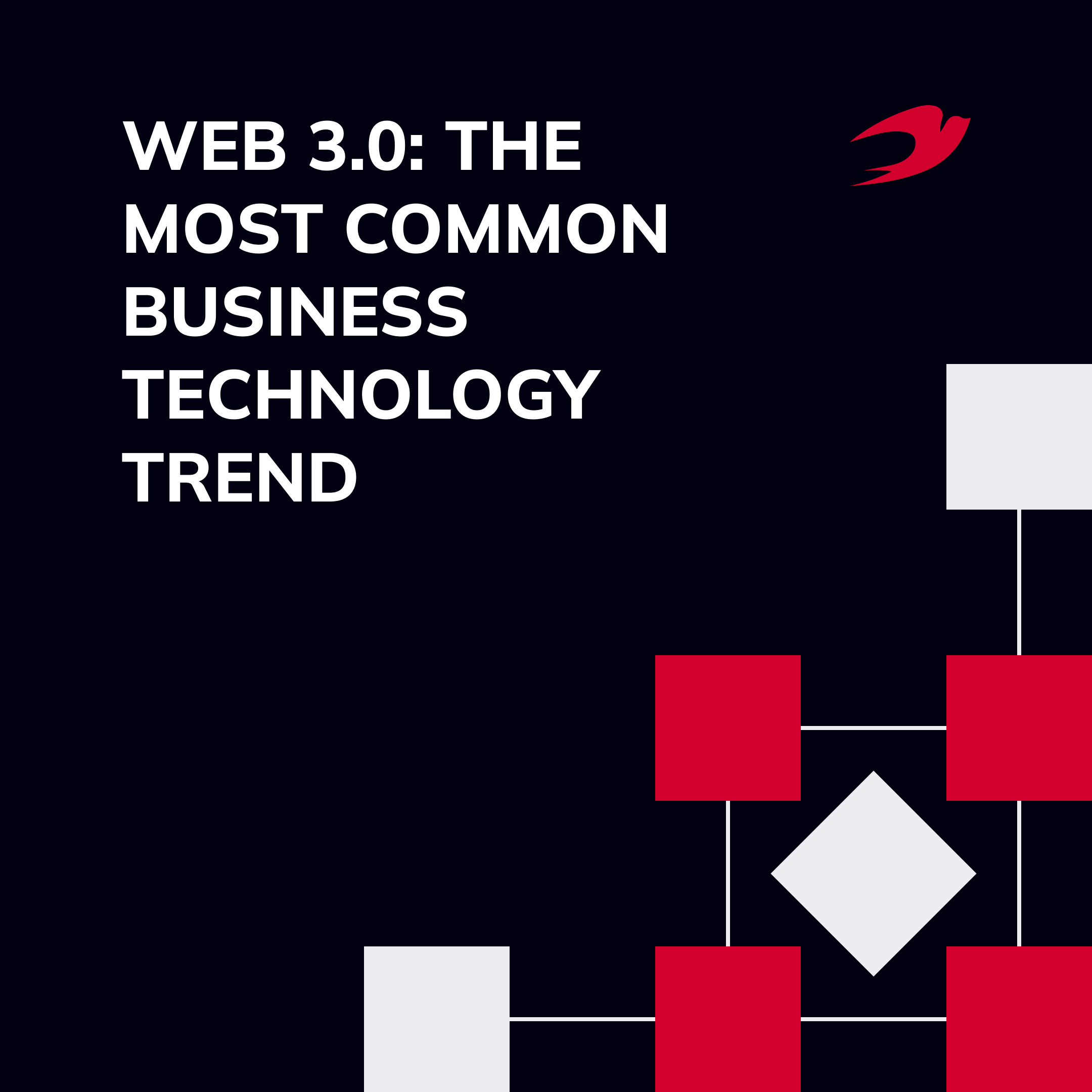The cryptocurrency market is about to reach 992.5 million users by 2028, which makes web3 a great trend itself. But what about the trends that drive the crypto market itself? At IdeaSoft we work closely with numerous blockchain startups and always stay up-to-date with the latest technology achievements and brand-new strategies.
Our extensive case study portfolio also shows our in-depth web 3.0 expertise. In this article, we will share our thoughts about the latest blockchain industry trends and describe them in more detail.
Table of contents:
- What is Web 3.0?
- Top web 3.0 trends
- Advantages of Web 3.0
- Comparison of Web 3.0 vs. Web 2.0
- Blockchain at the core of Web 3.0
- Challenges of implementing Web3.0 into business
What is Web 3.0?
Web 3.0 is taking shape right now as you read this article.
Web 3.0 is a concept of the Internet in which new “people’s” social networks, search engines, and trading platforms are emerging with no host companies. Blockchain, artificial intelligence, cryptocurrencies, and metaverses are key technologies in the new Web 3.0 era.
Signs of Web 3.0 are:
- Decentralization
- Blockchain
- Use of cryptocurrency as the primary currency
- Semantic Web
- NFT and Metaverses
- Virtual and augmented reality
- Privacy protection
- IoT
The main concept behind the Web 3.0 era is that it does not rely on centralized servers that belong to specific people or companies. They can be replaced by a distributed database that is stored differently. If we are talking about your classic apps (Apps), they are transforming into decentralized apps (dApps). The author of the Web 2.0 concept, Tim O’Reilly, proposed to define Web 3.0 as the interaction of the Internet with the physical world.
Top Trends in Blockchain Technology That Are Shaping The Industry
Due to our research and numerous visits to leading industry events such as Consesnsys Conference, WebSummit, Token2049, Blockchain Week, ETH community events, etc., we foresee that 2024 is poised to witness groundbreaking trends that will shape the future of the decentralized ecosystem. In this section, we explore the top seven Web 3.0 future trends that are expected to dominate the crypto space in 2024, each presenting novel opportunities and advancements.
DeFi 2.0
Building on the success of DeFi, the next iteration (DeFi 2.0) will introduce innovative protocols, interoperability, and enhanced user experiences. Expect decentralized lending, borrowing, and yield farming to reach new heights, further challenging traditional financial systems.
ReFi Solutions
ReFi emerges as a sustainable and ethical approach within the crypto space. Projects focusing on environmental impact, social responsibility, and community regeneration will gain prominence. Blockchain-based solutions will drive positive change and foster a more regenerative and inclusive financial ecosystem.
Zero-Knowledge Proofs Revolution
ZKPs remain one of the biggest trends in blockchain and now will become a cornerstone of privacy and security in blockchain transactions. With advancements in cryptographic techniques, ZKPs will empower users to prove the authenticity of information without revealing the actual data. This trend will find applications in various sectors, from finance to healthcare.
Cross-Chain Operability Unleashed
Overcoming the siloed nature of blockchains, cross-chain operability will take center stage among blockchain trends. Projects and protocols facilitating seamless communication and transactions across different blockchain networks will foster greater collaboration and efficiency within the decentralized ecosystem.
Account Abstraction and Social Recovery
The integration of account abstraction and social recovery mechanisms will enhance security and user accessibility. Users can regain access to their accounts through social connections, reducing the risks associated with lost private keys. This marks a significant step toward user-friendly blockchain experiences.
Tokenization of the Real-World Assets
Tokenization continues to evolve beyond digital assets trends. Real-world asset tokenization, including real estate, art, and other tangible assets, becoming even more prevalent. This trend not only enhances liquidity but also democratizes access to traditionally exclusive investment opportunities.
SocialFi – Bridging Social Media and Finance
The convergence of social media and decentralized finance, known as SocialFi, will reshape online interactions. SocialFi platforms will leverage blockchain technology to enable users to seamlessly transact, share assets, and participate in financial activities within their social communities.
Advantages of Web 3.0 technology for businesses
Who will pay for Web 3.0? Advertising currently pays for and gives life to most content on Web 2.0. This has led to monopolies and a hegemony of Internet advertising that controls the flow of information.
New models of monetization should be used to eliminate this unhealthy control over the “funding” and “organization” of the Internet. Cryptocurrencies and instant microtransactions will allow everyone to pay for Internet content directly.
Advantages of Web 3.0 are:
- Enhanced privacy & anonymity
- No central point of control. Intermediaries are removed. Blockchain gives a platform on the principle of “trust no one” (which leads to consensus), where rules are unbreakable, and data is fully encrypted.
- Data ownership. End users will have full control over their data and provide encryption. Information can then be divided into private and authorized. Users can share their information if they want.
- Uninterrupted access. Anyone can create an address and interact with the network.
- Automated service. Suspension and denial of service are greatly reduced. Since there is no single point of failure, service disruptions will be minimal.
Web 3.0 will shift power from the big Internet corporations to the users and creators of the Internet. At IdeaSoft, we can help you safely implement Web 3.0 technology in your project or even launch your own startup whether it is a crypto project, a fintech product, or a B2B solution. Having over 5 years in blockchain development under our belts allows us to work on the most complicated tasks.
Thinking of implementing web 3.0 technologies into your business?
Let us help you figure it out, and correctly draw up the requirements for your project
Moving to Web 3.0 and implementing this technology in your project will allow you to: have data safety thanks to new mechanisms, reduce hacking risks thanks to decentralization, and eliminate users or companies’ data theft. And this isn’t even the entire list of advantages you will get by adapting to Web 3.0. But most importantly, you should understand that companies that adapt to Web 3.0 will have a great advantage over their competitors.
Comparison of Web 3.0 vs. Web 2.0
Now let’s discuss the key differences between Web 2.0 and Web 3.0.

Now you fully understand the differences between Web 2.0 and Web 3.0.
Why is blockchain at the core of Web 3.0 technology?
Blockchain fully reflects the idea of Web 3.0. Anyone can create and record information of any kind and content. It is up to them to decide how to use it, where to distribute it, sell it, and how to value it. Cryptocurrency also supports Web 3.0 and will be its main component. The user can earn cryptocurrency online, purchase it, store it, and use it at their discretion.
NFTs, as a particular digital phenomenon of the art of blockchain, are also part of the future Web. This is partly because the creation, sale, and distribution of NFTs is not centralized. It all depends on the owner of a particular NFT and its demand. There are tons of NFTs worldwide, and they are all different.
There are also many NFT marketplaces where people can sell and buy NFTs. They are highly popular, and their current supply isn’t enough for the market demand. By the way, at IdeaSoft, we have already developed a few. Working with an experienced NFT development company can help businesses create custom NFT platforms tailored to market needs and user preferences.
Challenges of Implementing Web3.0 into Business
However, the integration of Web 3.0 technologies into existing business frameworks brings a few challenges, ranging from technological complexities to regulatory uncertainties. Understanding and addressing them is crucial for companies looking to harness the benefits of decentralized technologies. Let’s take a look.
Interoperability Challenges
Achieving seamless interoperability between protocols based on different blockchain networks and legacy systems remains a significant hurdle. Businesses often grapple with integration complexities when adopting decentralized solutions, leading to inefficiencies and potential disruptions.
Regulatory Uncertainties
The regulatory landscape surrounding Web 3.0 technologies is evolving, and businesses may face uncertainties in compliance. Varying regulatory approaches globally pose challenges, particularly in areas such as data privacy, tokenization, and decentralized finance (DeFi), where regulations may not be well-defined.
Yet, we see that many countries are overcoming this challenge and more and more governments are starting to accept crypto assets and give them a status of financial assets or securities, etc. Also, the European Commission has proceeded with the MiCA regulations which will come into force in the mid to end of 2024 and start the great era of cryptocurrency regulatory base in European countries.
Scalability Issues
Blockchain networks, especially public ones, often face scalability issues. As business activities increase on the blockchain, transaction speeds may slow down, and fees can become unpredictable. This scalability challenge may hinder the widespread adoption of decentralized solutions.
Based on our extensive portfolio of projects and more than 7 years of market-related experience, our development team knows perfectly how to address all of those challenges and make your product strive in the blockchain space and in the meantime be adjusted to the latest web3 trends.
Want to develop a project?
Let us help you figure out all the details, and consult you on the one-to-one meeting with our tech specialist! Schedule your consultation
Conclusion
Now you know what are web3 trends and how to address the main challenges this technology can bring. Businesses that have followed Web 3.0 have an advantage over competitors. First, it is getting increased attention from target audiences. Second, it will provide increased data security which will also attract new clients. For businesses aiming to scale quickly and efficiently, IT outstaffing is a powerful solution to access top Web3 talent and reduce development costs.
Third, there are exciting developments in SocialFi, which merge social media and decentralized finance, creating new ways for users to monetize their content and interactions. Fourth, businesses get more precise targeted ads thanks to AI use. As these technologies gain traction, they will undoubtedly contribute even more to the ongoing transformation of traditional industries and pave the way for a more decentralized and inclusive future.

